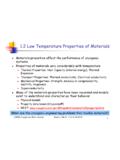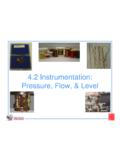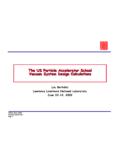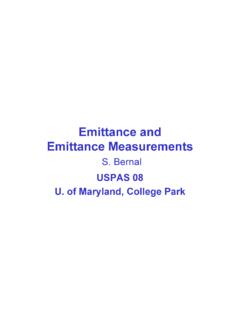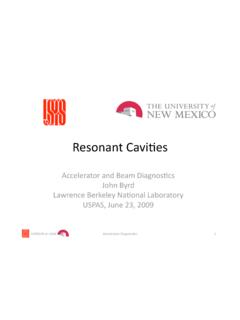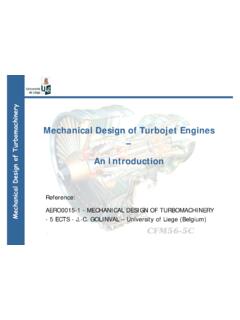Transcription of 1.2 Low Temperature Properties of Materials
1 USPAS Cryogenics Short CourseBoston, MA 6/14 to 6/18 Low Temperature Properties of Materials Materials Properties affect the performance of cryogenic systems. Properties of Materials vary considerably with Temperature thermal Properties : Heat Capacity (internal energy), thermal Expansion Transport Properties : thermal conductivity, Electrical conductivity mechanical Properties : Strength, modulus or compressibility, ductility, toughness Superconductivity Many of the Materials Properties have been recorded and models exist to understand and characterize their behavior Physical models Property data bases (Cryocomp ) NIST: are the cryogenic engineering problems that involve Materials ?
2 USPAS Cryogenics Short CourseBoston, MA 6/14 to 6/18/20102 Cooldown of a solid component If the mass and type of the object and its material are known, then the heat content at the designated temperatures can be calculated by integrating 1stLaw. The heat removed from the component is equal to its change of internal energy,mTi = 300 KTf = 80 K = ifTTCdTmELiquid nitrogen @ 77 KmpdvdETdsdQ+==~ 0 Cryogenics involves cooling things to low Temperature . Therefore one needs to understand the Cryogenics Short CourseBoston, MA 6/14 to 6/18/20103 Heat Capacity of Solids General characteristics: The heat capacity is defined as the change in the heat content with Temperature .
3 The heat capacity at constant volume is, These two forms of the heat capacity are related through the following thermodynamic relation,vvTEC =and at constant pressure,ppTsTC = 22 TvvpTvTCCTpvp= = pTvv =1 Tpvv =1 VolumeexpansivityIsothermalcompressibili tyNote: Cp Cv is small except for gases, where ~ R = J/mole (T)T(K)03003rd Law: C 0 as T 0 USPAS Cryogenics Short CourseBoston, MA 6/14 to 6/18/20104 Heat Capacity of Solids (Lattice Contribution) Lattice vibration (Phonon) excitations are the main contributionto the heat capacity of solids at all except the lowest temperatures. Internal energy of a phonon gas is given by D( )is the density of states and depends on the choice of model n( )is the statistical distribution function Debye Model for density of states Constant phonon velocity Maximum frequency = D Debye Temperature : D= h D/2 kB()() nDdhEph =2()112 =TkhBen h = Planck s constant = x 10-34 = Boltzmann s constant = x 10-23 J/K USPAS Cryogenics Short CourseBoston, MA 6/14 to 6/18/20105 Debye Internal Energy & Heat Capacity In Debye model the internal energy and heat capacity have simple forms where x = h /2 kBT and xD= D/T Limits.
4 T > D, (Dulong-Petit value) T << D, () = =DDxxxDphxxDpheexdxTRCexdxTRTE02430331919 32343 DphphTRCRC Example== J/mole K (gas constant)K-lUSPAS Cryogenics Short CourseBoston, MA 6/14 to 6/18/20106 Values of Debye Temperature (K)Metals1 & Compounds2 DC (graphite)2700C (diamond)2028H2 (solid)105-115He (solid)30N2 (solid)70O2 (solid)90Si630 SiO2 (quartz)255 TiO2450 The Debye Temperature is normally determined by measurements of the specific heat at low Temperature . For T << D ,1 Kittel, Introduction to Solid State Physics2 Timmerhaus and Flynn, Cryogenic Process Engineering3234 DphTRC USPAS Cryogenics Short CourseBoston, MA 6/14 to 6/18/20107 Electronic Heat Capacity (Metals) The free electron model treats electrons as a gas of particles obeying Fermi-Dirac statistics Where and At low temperatures, T << f/kB~ 104K()() fDdEe =()11+= TkBfef ()212322282 =hmVDf( ) T = 0T > 03222238 VNmhf ()TTkDCBfe = 2231 The electronic and phonon contributions to the heat capacity of copper are approximately equal at 4 KUSPAS Cryogenics Short CourseBoston, MA 6/14 to 6/18/20108 Summary.
5 Specific Heat of MaterialsGeneral characteristics: Specific heat decreases by ~ 10x between 300 K and LN2temperature (77 K) Decreases by factor of ~ 1000x between RT and 4 K Temperature dependence C ~ constant near RT C ~ Tn, n ~ 3 for T < 100 K C ~ T for metals at T < 1 KUSPAS Cryogenics Short CourseBoston, MA 6/14 to 6/18/20109 thermal Contraction All Materials change dimension with Temperature . The expansion coefficient is a measure of this effect. For most Materials , the expansion coefficient > 0ppTTvv = = 11 311= =pTLLBulk expansivity (volume change):Linear expansion coefficientFor isotropic materialsExpansivity caused by anharmonic terms in the lattice potentialT1 ~ 300 KT2 < T1 LD D- DUSPAS Cryogenics Short CourseBoston, MA 6/14 to 6/18/201010 Temperature dependence to and Most Materials contract when cooled The magnitude of the effect depends on Materials Plastics > metals > glasses Coefficient ( ) decreases with Temperature Thermodynamics: 002 = TvpTvCC 00 = TTppsTv(Third law.)
6 S 0)From Ekin (2006)USPAS Cryogenics Short CourseBoston, MA 6/14 to 6/18/201011 Expansion coefficient for materialsUSPAS Cryogenics Short CourseBoston, MA 6/14 to 6/18/201012 thermal contraction of supports The change in length of a support is determined by the Temperature distribution along the support Tabulated L/L values are for uniform Temperature of support For non-uniform temperaturemTLLATHmTL L (greatly exaggerated)THxTLLA ctual T(x)()()dTTdxLLTxTH = 0 Where T(x) is defined according to,()()dTTkLxdTTkHLHxTTTT =USPAS Cryogenics Short CourseBoston, MA 6/14 to 6/18/201013 thermal stress in a composite Assumptions: Composite is stress free at T0 Materials remain elastic: No slippage at boundary Ends are freeA2A1 LForce balance222111 AFAF === yE=compositeLLLL =11 22 LLLL composite = + ==22112111111 AEAELLLLEE yyyy USPAS Cryogenics Short CourseBoston, MA 6/14 to 6/18/201014 Electrical conductivity of Materials The electrical conductivity or resistivity of a material is defined in terms of Ohm s Law: V = IR Heat generation by electrical conduction Q = I2R Conductivity ( ) or resistivity ( ) are material Properties that depend on extrinsic variables.
7 T, p, B (magnetic field)IVALALALR ==IVR = dV/dIUSPAS Cryogenics Short CourseBoston, MA 6/14 to 6/18/201015 Instrumentation leads An instrumentation lead usually carries current between room Temperature and low Temperature Material selection (pure metals vs. alloys) Lead length determined by application Optimizing the design Leads are an important component and should be carefully designed Often one of the main heat loads to the system Poor design can also affect one s ability to make a leadUSPAS Cryogenics Short CourseBoston, MA 6/14 to 6/18/201016 Cryogenic Temperature sensors A Temperature sensor is a device that has a measurable property that is sensitive to Temperature .
8 Measurement and control of Temperature is an important component of cryogenic systems. Resistive sensors are frequently used for cryogenic Temperature measurement Knowing what Temperature is being measured is often a challenge in cryogenics (more later)IVTR=)(TUSPAS Cryogenics Short CourseBoston, MA 6/14 to 6/18/201017 Electrical Conductivity in Metals Resistivity in metals develops from two electron scattering mechanisms (Matthiessen s rule) Electron-phonon scattering, T > DScattering probability ~ mean square displacement due to thermal motion of the lattice: <x2> ~ kB Tand ~ T Electron-defect scattering ( Temperature independent), T << DScattering depends on concentration of defects ~ 0 ~ constant.
9 Residual Resistivity Ratio (RRR = (273 K)/ 0 )indication of the purity of a metal Intermediate region, T ~ D/3 ~ (phonon density) x (scattering probability) ~ T5 Scattering process:l l is the mean free path is the mean scattering time = l/vfUSPAS Cryogenics Short CourseBoston, MA 6/14 to 6/18/201018 Resistivity of Pure Metals ( Copper)Residual ResistivitydR/dT ~ constantR ~ constantUSPAS Cryogenics Short CourseBoston, MA 6/14 to 6/18/201019 Kohler plot for Magneto-resistanceThe resistance of pure metals increases in a magnetic field due to more complex electron path and scattering (Why?)How to use a Kohler plot?1. Determine RRR of metal2. Compute product: RRR X B3.
10 Use graph to estimate incremental increase in R (or ).4. Add to base valueExample:RRR = 100B = 10 T R/R = 3R(10 T)/R(0 T) = 4 RRR (equival.) = 25( ) = 1000 CopperUSPAS Cryogenics Short CourseBoston, MA 6/14 to 6/18/201020 Electrical conductivity of alloysElectrical resistivity of various alloys (x 10-9 -m) (from Cryocomp)Alloy10 K20 K50 K100 K200 K300 KRRRAL 4% (56-44) Cryogenics Short CourseBoston, MA 6/14 to 6/18/201021 Electrical conductivity of semiconductors Carrier concentration Energy gap Impurity concentration ~ 10-4to 107 m Basis for low Temperature thermometryConductivity depends on the number of carriers in the conduction band.
